![Two Young Yé-Yé Girls with Sunglasses, 1965, Abdourahmane Sakaly, Mali [Courtesy of the Estate of Abdourahmane Sakaly, Bamako, Mali and Revue Noire, Paris/The McKinley Collection]](https://www.aljazeera.com/wp-content/uploads/2021/07/144-e1627027986772.jpg?resize=770%2C513)
The sitters for this photo, circa the 1950s, by Malian photographer Barthelely Koné, wear empire-waist dresses cut of densely patterned African cloth, their fashion a little African, a little European. The mother’s face is serene, open. Her slightly lowered eyes meet the viewer’s, the daughter’s even more directly.
Koné’s portrait is a “story of inheritance”, Catherine E McKinley writes in The African Lookbook: A Visual History of 100 Years of African Women, her recently published collection featuring 166 photos, including this one, taken between 1870 and 1970.
The girl in the photo, McKinley tells us, has “been given the heavily coded gifts of passage into puberty: permission to wear a mature woman’s hairstyle she has not quite grown into.” Perhaps she is even being positioned as a potential marriage prospect.
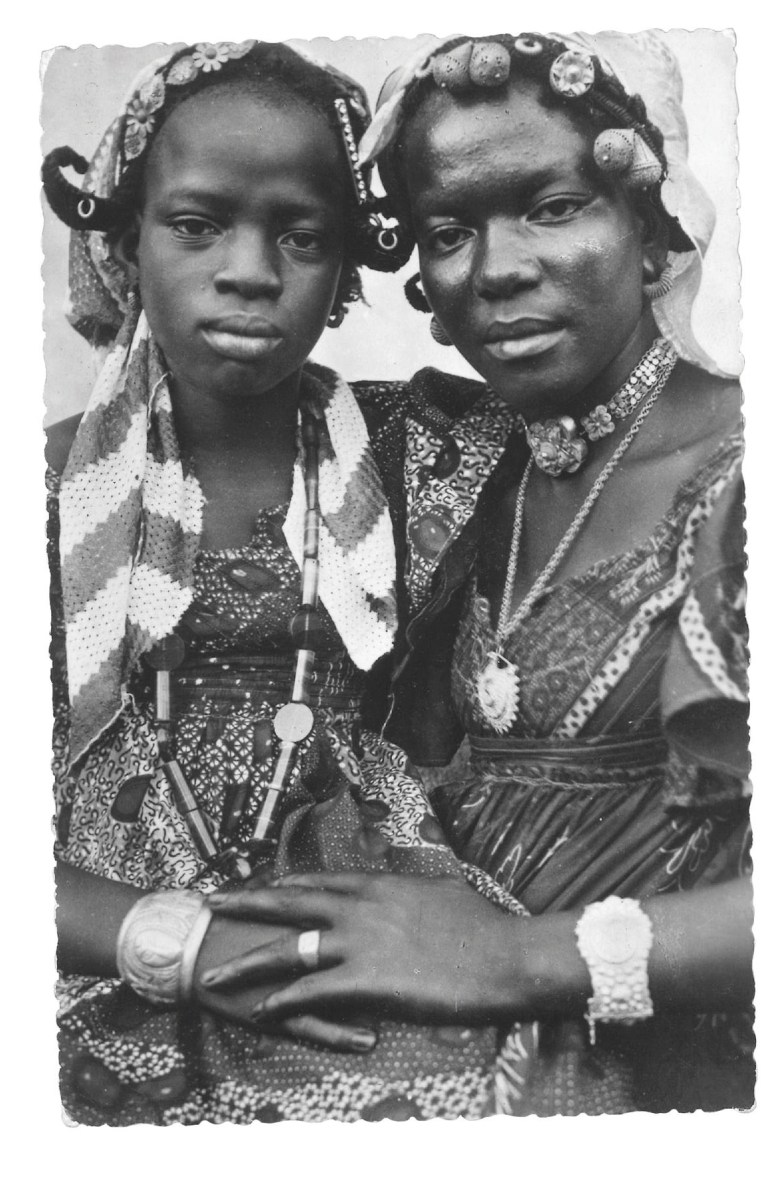 Untitled, c. 1950s, Barthelely Koné, Mali [Courtesy of The McKinley Collection]
Untitled, c. 1950s, Barthelely Koné, Mali [Courtesy of The McKinley Collection]The gaze of the mother and her firmly planted hand suggest a sort of unspoken but purposeful visual vocabulary, or code, at the moment of making the image. But this photo – along with the others in The African Lookbook – also raises many questions:
The woman and her daughter: Were they willing participants in the photo? Or seated at a husband’s behest, to highlight his possessions – his wife, his daughter, their jewellery? Is the pose their own, or was it staged by the photographer? Is the jewellery part of the young girl’s dowry? Is that tension we see on her forehead? Was the image later duplicated by the photographer for distribution and sale? With or without the sitters’ permission?
Powerful and painful narratives
A lookbook is fashion parlance for a designer’s collection overview. Similarly, the African Lookbook – which weaves together historical photos and McKinley’s own research and musings – offers an encapsulation of, and a window into, the rich history of West African photography – and the women who were at the centre of the frame.
In the book, McKinley explores not only a range of pictures – many from her personal archive, The McKinley Collection – but also the previously unexamined role of the photos’ female subjects, and along with it, the story of the cloth they wore and the sewing machines that turned it into fashion. To the women, and particularly the sitters in the photos, the cloth was a means of telling a story about themselves: the print, the dye, how they wrapped it, wore it, and had it cut and sewn.
 Untitled, undated, photographer unknown, Benin [Courtesy of The McKinley Collection]
Untitled, undated, photographer unknown, Benin [Courtesy of The McKinley Collection]“Women are the disproportionate subject of colonial era African archives,” McKinley says, in an email dialogue. “Their images serve a very particular role in the project of empire … And yet women were able to use photography, textiles, and the sewing machine for considerable power.”
McKinley, who is Black, Jewish, and Choctaw, began archiving these photos in 1991. Her initial image was of Kwame, the houseboy she met on her first trip to Ghana. “When I left, he gave me a photo of himself in his church clothes, on a bike, holding a chicken flapping its wings,” says McKinley.
Collecting these images became a passion and a commitment for her, and perhaps a replacement for the dearth of family images available to her as a child whose early life was spent in foster care. She was later adopted by WASP parents.
McKinley, who has since spent long periods of time in Ghana, focused The African Lookbook largely on West Africa and the Atlantic coast, areas she had travelled pursuing the trade routes of cloth for her book, Indigo: In Search of a Color that Seduced the World, which traced the history of that highly valued dye and its deep-blue resist-stitch cloth – so valuable that one length could once be traded for a human body. Her research eventually took her on a journey through nine African countries.
 Untitled, c. 1960, Youssef Safieddine, Studio Safieddine, Senegal [Courtesy of The McKinley Collection]
Untitled, c. 1960, Youssef Safieddine, Studio Safieddine, Senegal [Courtesy of The McKinley Collection]McKinley began gathering photos that were both meaningful and beautiful to her. She also saw them as an alternative to the myth-making images of influencers and celebrities in Ebony and Jet magazines, which were about and marketed to Black Americans.
Explains McKinley, “The images from Ebony, Essence, etc. acted as counter-narratives to those of National Geographic and the war and poverty porn of the Western media that dominated the ’70s on. But they created a troubling mythology in their attempt to establish a respectability politics of prestige: a focus on ancient kings and queens; music and sports celebrity; modern royalty; and the pomp and stunning displays of power by politicians who through their US schooling were closely tied to African American leadership, even while they exhibited troubling behaviours on the world stage.
“I was always uncomfortable with these narratives, but I also admit to being held by the seductive powers of a shining Motherland.”
Capture and conquest
A 1956/1957 photo by Seydou Keïta depicts two women seated against a swirling, almost mod print, the women’s elaborate dresses cut from printed and textured cloth, their hair adorned with beads and wraps. Their right wrists sport a cuff and their left a good-size European-style watch. The woman on the left appears slightly older and wears a wedding band; she doesn’t smile for the camera. The woman on the right – her daughter? A second wife? A sister? – appears more relaxed, and a smile graces her face.
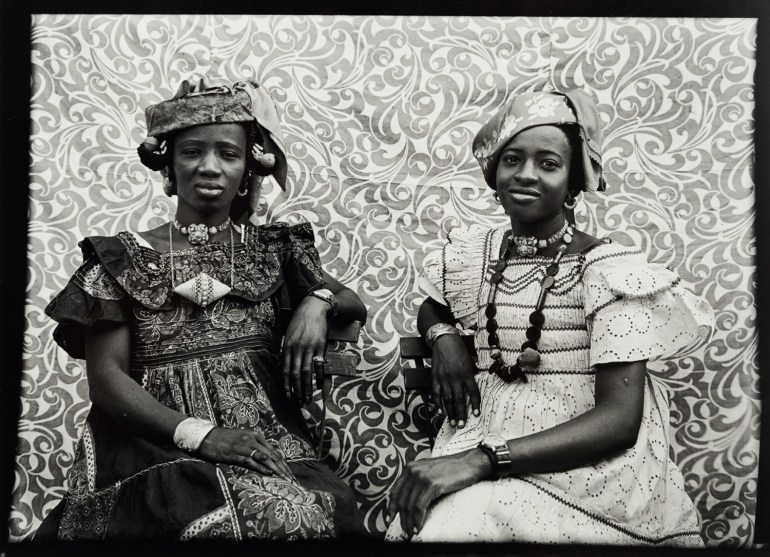 Untitled #460, 1956/1957, Seydou Keïta, Mali, Copyright Seydou Keïta/SKPE [Courtesy CAAC – The Pigozzi Collection/The McKinley Collection]
Untitled #460, 1956/1957, Seydou Keïta, Mali, Copyright Seydou Keïta/SKPE [Courtesy CAAC – The Pigozzi Collection/The McKinley Collection]McKinley explains that dressing could be a statement, a point of seduction, or a point of entry into upper, often colonial echelons. The women in these studio portraits dressed, adorned, and preened themselves for the camera, participating in a story they hoped to project about themselves.
Other images, on postcards and cartes de visite (small photographic portraits mounted on a piece of card), reveal more troubling and painful narratives. The Wife of the Sultan of Mwenda and Her Servant – photographed by Gabriel L in the Congo, circa 1900, shields a sinister subtext. The large smiling wife wears stockings, heels, and Christian clothing of white linen. Her arms are lined with ivory bangle bracelets, which, McKinley notes “mark her as a woman who owns many other human lives”. Her sombre servant kneels behind her, yet another symbol to show off her status.
In an undated photo, a “femme de dos” – a female subject whose exposed back, with its built-in eroticism, is the focus of the camera – tilts her head downward, as though in shame. Raised scars fan out from her spine like the traces of wings, decorated and perhaps coded skin – a fetish object in the eyes of colonials who saw in it evidence of witchcraft and the denial of a Christian God.
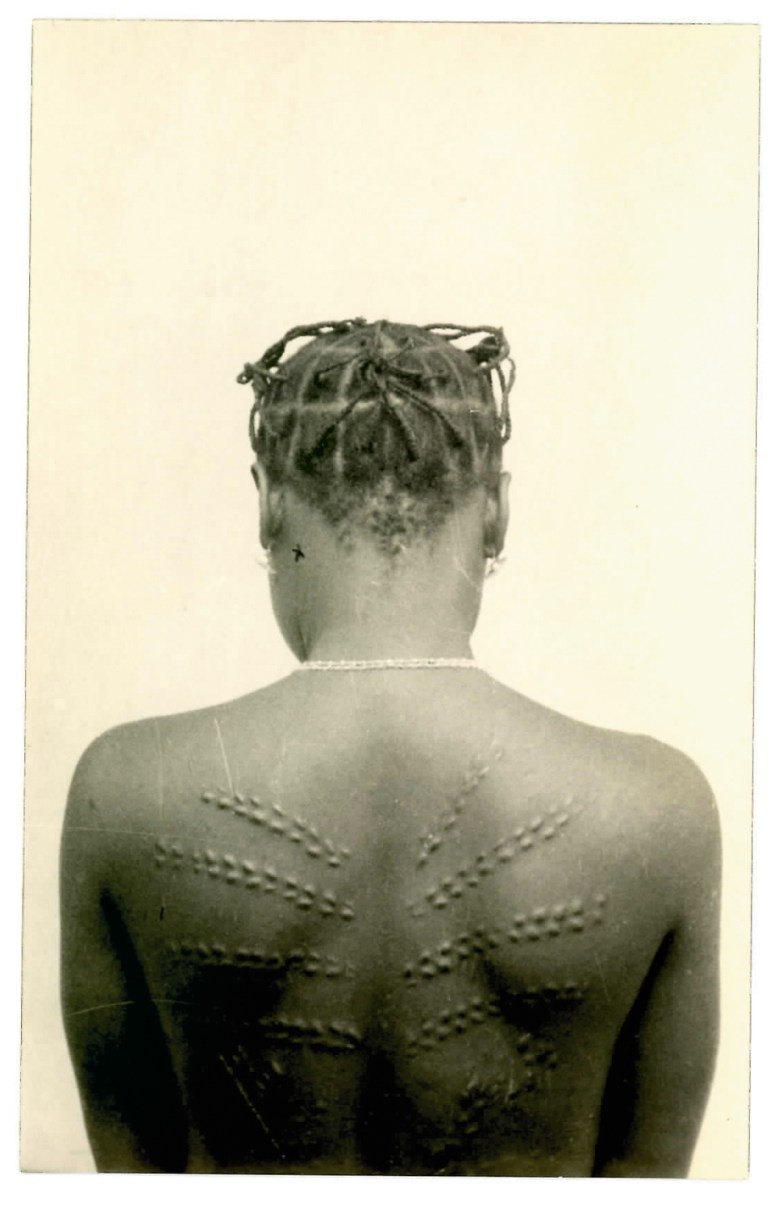 Femme de dos, undated, photographer unknown [Courtesy of The McKinley Collection]
Femme de dos, undated, photographer unknown [Courtesy of The McKinley Collection]Otufo Girls – Fetish Virgins, Crobo Gold Coast Colony (circa 1910) depicts the heavily beaded, pagne-wearing young women adorned in beads against a classical columned backdrop and lined up by alternating height and breast shape.
The first photo studios
Photography was born of an impulse to record and reproduce the image of a person, place, or thing. The subject was “shot” and “captured” through the light and the lens and then subsumed in a silver emulsion on a treated glass or paper. Perhaps later it was preserved in a frame or traded as a postcard – the image and, by extension, the sitter (often an “exotic woman”) ultimately becoming the property of whoever was in possession of the photo, which someone could buy, sell, and trade. The female body has always been about capture and conquest, even in Western photography, but especially in the photography of African women by non-Africans.
Ten months after the invention of the daguerreotype in 1839 France, colonial photographers fanned out across Egypt, Africa, and India, and across Europe, the US, and Latin America, recording its wonders.
The earliest photographers in Africa were mostly European, but Africans quickly followed suit, establishing photo businesses in the continent’s capitals. Many also wandered the African coast, often setting up studios in port cities.
 Untitled, 1890, L Hostalier, Photographie des Colonies Paris, Senegal [Courtesy of The McKinley Collection]
Untitled, 1890, L Hostalier, Photographie des Colonies Paris, Senegal [Courtesy of The McKinley Collection]The first West African photo studio was opened in Monrovia, Liberia, in 1853; it was run by Augustus Washington, the son of an enslaved African American father. Washington, who for a time attended Dartmouth College, began his career in the US before moving to Liberia. He made daguerreotypes of the upper classes and politicians, as well as for the American Colonization Society, to help construct an idealised narrative of Liberia for Western audiences.
By the 1870s, Sierra Leonean Francis W Joaque and Gambian John Parkes Decker were known for their craft. The Ghanaian George Lutterodt and his son Albert established a photo business in Accra, Gold Coast; the Togolese Alex Agbaglo Acolatse, a trainee of the Lutterodts’s, also did so in Togo. In the early 1900s, in Freetown, Sierra Leone, Creole brothers Alphonso and Arthur Lisk-Carew put their cameras to work for both the African and European communities. Photo studios proliferated in East Africa from the 1890s through the 1920s, especially along the Swahili coast. Europeans like François-Edmond Fortier also travelled through West Africa, making “ethnographic” images that would similarly circulate as postcards; he was said to have published more than 3,500 between 1900 and 1912.
Many photographed the African upper class, including family portraits and social events. The Lisk-Carews also travelled beyond the cities to make pictures that would later circulate as postcards. Alphonso became known for his postcard portraits of “Bundoo girls”, initiates of a pan-ethnic women’s cultural society said to be secret and who became the fascination of Europeans.
“The majority of the first practitioners were from everywhere,” explains Giulia Paoletti, an assistant professor of art history in the Department of Art at the University of Virginia who is currently completing Objects of Betrayal: On Photography and Visuality in Senegal, a book on the history of photography in Senegal. “They were travelling along the coast. They were entrepreneurs. So it gave a global edge to this history [of West African photography] that we don’t find in France and in England, where they were fighting and defending if it was a British or a French thing.”
Women also opened studios, but our records of them, as McKinley points out, are conspicuously few. Carrie Lumpkin opened her studio in Lagos, Nigeria, in 1908. Felicia Abban opened Mrs Felicia Abban’s Day and Night Quality Art School, in Jamestown, Accra, in 1953.
 Group of the Circumcised, undated, A Albaret, Conakry, French Guinea [Courtesy of The McKinley Collection]
Group of the Circumcised, undated, A Albaret, Conakry, French Guinea [Courtesy of The McKinley Collection]Pictures shot in Africa were often printed en masse in Europe and then shipped back to Africa to be sold to tourists. Many were disseminated across Europe as postcards. Pablo Picasso was said to have collected and drawn on these images for inspiration. Some pictures became tools of pseudo-science, employing the most unscientific racial typologies and comparisons with the ultimate aim of asserting through photographic evidence what was said to be the inherent physical and mental inferiority of the African – in contrast to the intrinsic superiority of the European. Some were intended for fantasy fulfilment – for their sexual allusions but also for their empowerment of the myth of empire: to display colonial conquests and justify imperialism and the subjugation of another people.
Colonial images strove, in their framing, captioning, and content, to depict godless and barbarous tribes undeserving of their lands and desperate for colonial civilising and ownership – of both the lands and their people. Zimbabwean novelist Yvonne Vera has often been quoted as saying, “In Africa … the camera arrives as part of colonial paraphernalia, together with the gun and the bible.”
Two Captives from French Sudan (1903), in which its two female subjects stand on display under a “fetishizing lens”, bare-breasted, one with raised scars radiating from her belly, recalls the pictures of prisoners of war by the photographer Ettore Navarro in Maaza Mengiste’s novel The Shadow King. Navarro is a conscript in the Italian army during its war in and occupation of Ethiopia, from 1935 to 1941. His job is to take pictures of the Ethiopian captives at the instant of their death, as they are brutally tossed, alive, over cliffs. These images, both in the story and in real life, were printed as postcards and circulated in Italy to rally nationalism and support for the war. This was not uncommon practice; during World War II, the Nazis made and distributed similar images of Jews at the instant of their extermination.
 Point hairstyle, undated, photographer unknown, location unknown [Courtesy of The McKinley Collection]
Point hairstyle, undated, photographer unknown, location unknown [Courtesy of The McKinley Collection]Portraiture and cloth
The study of African photography is relatively new. Images in museums were considered as adding context to existing artefacts but not worthy of examination in their own right. Only in recent decades have these photos been explored, archived, and collected. Attempts to decode these images are now being made based on historical and cultural context, as well as on fashion, hairstyle, accessories, pose, gestures, and camera angles.
Paoletti explains, “We’re only beginning to understand these objects and even to understand the basic historical trajectories: Who were the first photographers? Who were the first sitters? What was the interaction? And the situation? We can make generalizations, but the situation changes a lot, from city to city and country to country, from decade to decade.”
How do we fully understand the layers of interactions that led to these photos? What role did fantasy and dress-up play? To what extent were these images aspirational? Can we assume the bare-breasted women in the postcards had any less agency than the women who at the same time modelled for painters in Paris? Or that they were not paid? (Even though in East Africa, there were bonded and enslaved women whose role was to wear elaborate costumes and perform for public display, and who were often the subjects of studio photos.) To what extent do the studio portraits reflect acts of resistance – and to what degree do they simply reinforce social status?
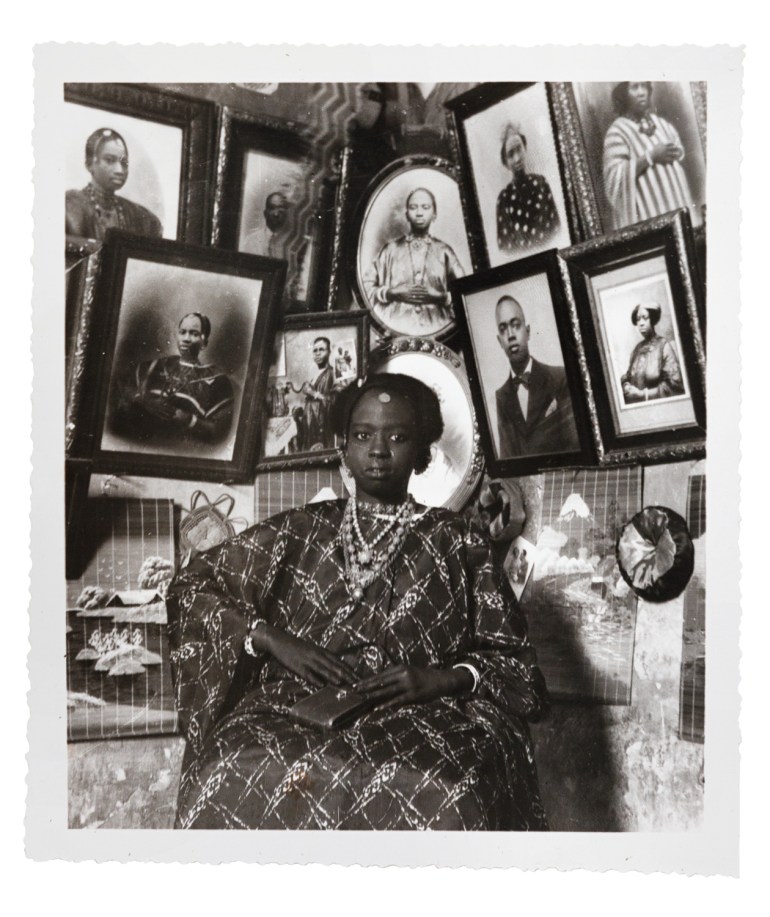 Untitled, c. 1930, photographer unknown, from the Collection of Aladji Adama Sylla, Saint-Louis, Senegal [Courtesy of The McKinley Collection]
Untitled, c. 1930, photographer unknown, from the Collection of Aladji Adama Sylla, Saint-Louis, Senegal [Courtesy of The McKinley Collection]Photo portraiture’s poses – the sitter seated facing the camera, hands planted in her lap, looking straight into the lens, or standing, with a hand on the hip, for instance; or what was once the images’ pervasive unsmiling solemnity and later transformed into the omnipresent smile – could be remarkably similar worldwide. (Think of the ubiquity of the selfie’s duck lips.) Yet, as universal as some of these poses were, African photographers also developed their own vernacular and aesthetic.
Says Paoletti, “After a while, you notice certain body postures: the knees apart, for instance. That’s a posture that you wouldn’t find at that time in the West – the spreading of the legs, sitting with knees open, so you can see the textile and the hands resting on the knees. That’s a very rich posture … It’s obviously pointing to the textile. You’re showing the textile. So it gives this gravitas, this weight to the portrait… [It emphasises the seriousness that we see] in those faces, with the legs down, firm down, with those hands down. There’s a majesty and a presence that one cannot disregard.”
“Cloth,” as McKinley notes, “was for beauty, less for cover than for embellishment.” The cloth might adorn the body or the photo, as a backdrop.
The African Lookbook is not only a story of early West African photography and fashion, it’s also the story of Vlisco fabrics. Its ubiquitous prints, produced in the Netherlands, were based on colourful wax designs “inspired by Africa”, Vlisco says, to appeal to Africans. Its intricate patterns, some geometric, some borrowed from nature or traditional African markings and motifs, were imbued with special meaning by West and Central African merchants and their customers. Vlisco is still seen and known worldwide as “African fabric”, even among Africans themselves – though there is nothing African about its origins.
“There are many wax cloth producers, but Vlisco is one of the oldest and most iconic,” says McKinley in her email. “They are spoken of as the Chanel of Africa. For me, they best illustrate the relationship between colonialism – particularly the legacy of the transatlantic trade – and how it was sustained by textile economies. It also reveals how much African women have for centuries privileged cosmopolitanism and held up modernity through their penchant for new textile displays.”
 Our Elegants of Djenné, undated, H Danel, à Kayes, Mali [Courtesy of The McKinley Collection]
Our Elegants of Djenné, undated, H Danel, à Kayes, Mali [Courtesy of The McKinley Collection]A woman would often keep a cloth box, the contents of which would come to embody her dowry, her good taste, her spirit, and her story. Cloth allows for identification, not only by country or region but also by class. “Six bougies” (spark plugs), the brainstorm of a Portuguese trader to celebrate the six-cylinder car, was “a sign of wealth”, notes the Vlisco site. It was distributed by the company in the Congo, where it was consigned the meaning: “The wearer is a woman strong enough to take on six men.” Other designs were said to reference marital relationships. The Jumping Horse pattern was said to mean: “I run faster than my rival,” and to reflect on the dynamic between co-wives. Fabric, says McKinley, might be printed with an image of an engaged couple or a political leader – whom a woman might wear upside down or over the buttocks as a political statement.
“Photographers and cloth traders worked the same routes along the African Atlantic coast (Morocco to Angola)… up into the Sahel,” says McKinley. Sewing machines, she notes, arrived in Africa around the same time as the camera. They were a means of economic power, much as they are today. Owning or being able to work a sewing machine gave women pecuniary possibilities.
Less serious, more playful
With the 1960s came West Africa’s break from colonial bonds and the resulting burst of psychological freedom – and the desire to capture the frisson in a photo. There was optimism in the air and some extra pocket change in the hand. Studio portraits proliferated.
These mid-century photos have the verve of modern selfies, and much of their self-possession. The sitter inhabits and claims the frame rather than simply occupying its space.
The subjects wore more modern (read: Western) clothes, the length of skirts climbed, and European stockings became visible. Some women cast their headscarves aside to wear American-style Afros or beehives.
 Aunty Koramaa II, c. 1975 Diamond Photo Studio No. 4, Accra, Ghana [Courtesy of The McKinley Collection]
Aunty Koramaa II, c. 1975 Diamond Photo Studio No. 4, Accra, Ghana [Courtesy of The McKinley Collection]Tribal hairstyles and “precolonial modes of hairstyling that had been considered pagan or unsophisticated returned”, notes McKinley. Other hairstyles took inspiration from the newly funded architecture, with hair wound with mechanical thread and sculpted into mod shapes or radiating out from the head.
Posture became less stiff post-independence, the mood less serious, more playful. Some sitters appear to dare the camera. A smart, structured purse and a European watch appear prominently placed from the 1960s on, often centred on the sitters’ lap.
Two Yé-Yé Girls With Sunglasses, by Adourahmane Sakaly of Mali, is a 1965 photo steeped in jubilance and youthfulness. The two women sport smiles and short hair, bold round sunglasses, modern earrings and matching brocade halter tops.
The African Lookbook includes a lovely series of “Aunty Koramaa”, who appears in photos from Accra, Ghana, from 1956 through the mid-1970s, often smiling (a rarity in earlier West African photography) and wearing something stylish. In one photo from 1975, from Diamond Photo Studio No 4, she wears checkered bell-bottoms and a button-up top, holding a structured bag against a checked backdrop and patterned floor.
A new generation of African photographers
Many of the photographers behind these images remain anonymous. A few, like Keïta, who photographed the Malian upper classes; Malick Sidibé, who photographed Malian middle-class youth and street culture; and photographer Sanlé Sory, who captured Burkina Faso’s post-liberation youth and fashion – les yé-yé – at his Volta Studio, became celebrated for their distinct images and mise-en-scène, with backdrops and props that both capture a time, place, and people yet are also distinctly modern. Chief S O Alonge established his Ideal Photo Studio, in Benin City, Nigeria, where he produced portraits and advertising images in the 1940s and 1950s.
Ghana’s James Barnor established Accra’s Ever Young Studio in the early 1950s and was the rare African photographer who went on to have a lucrative photography career in Europe, shooting fashion – a survey of his work appears at London’s Serpentine Gallery until October 2021. In 1960s and 70s South Africa, a legacy of Black photojournalism developed through the print magazine Drum and with photographers like Ernest Cole, Bob Gosani, and Peter Magubane.
Eventually, colour photography and cheap and/or disposable cameras diminished the demand for studio photographers. But it also gave rise to a new generation of African photographers, including many women.
We tend to think of these earlier African photographers romantically as artists in their studio, especially today, as we collect their images as art. But the photographs were primarily a way to earn a living – less about art and more about commerce.
 Untitled, undated, photographer unknown, location unknown [Courtesy of The McKinley Collection]
Untitled, undated, photographer unknown, location unknown [Courtesy of The McKinley Collection]Alex Harsley, the 83-year-old photographer who helms 4th Street Photo Gallery and Minority Photographers, in New York, points out, “Look at what [Harlem portraitist James] Van Der Zee did and the people that he was supporting. It had nothing to do with poor people.” Van Der Zee (1886–1983), the illustrious Black studio photographer, made portraits of Harlem’s well-heeled and well-known, including Black luminaries like activist Marcus Garvey, musician Miles Davis, and artist Jean Michel Basquiat. Known as “the eyes of Harlem”, Van Der Zee carefully directed his prop-filled and idealised images to depict an urbane and sophisticated Black middle class. “Years have gone by, and now it’s valuable. But you’ve got to survive through that period,” adds Harsley.
For many, the photo, both as object and content, was a display of material wealth and social status. To display a photo was to display sophistication.
“Photography was a medium that arrived and in the beginning, the patrons were the upper class,” says Paoletti. “So whoever they were, they were the ones who had access to the first technologies and resources.”
Explains Harsley, “It goes back to – listen now – the Medicis. All right? It goes back to that. It’s a sense of power to have that kind of thing, your history, put in that context.”
The West African studio portraits utilised lush textile backdrops to signal stature and meaning much as the Medici portraits did for this politically powerful and privileged Florentine family, who used these paintings as a means of branding and asserting influence.
“Today we’re looking at questions like why one commissions a portrait, and why did they choose a particular studio,” says Paoletti.
 Untitled, 1900, Dunau, Lumière Society, Senegal [Courtesy of The McKinley Collection]
Untitled, 1900, Dunau, Lumière Society, Senegal [Courtesy of The McKinley Collection]Reclaiming African images for Africans
Novelist Mengiste, whose family fled Ethiopia when she was four and who grew up in Kenya, Nigeria, and the US, spoke to Al Jazeera in an online interview. She said of Ethiopian studio portraits: “It seemed at some point almost everyone went into a studio to have of these photographs made. And they were often in clothing that might signify work, what type of job they had. My mother wore a dress I think she wore for her high school graduation. This was not just any photograph. This was really a special occasion … My sense as a child was that these images, they looked ethereal, they looked otherworldly. And just so perfect … My father had a studio photo of him in his Ethiopian Airlines uniform. This was how he identified himself. He was so proud of it … But of course, my grandfather would have the shama and the suit underneath it. Or the shama and the traditional clothing.”
The photo was also said to be invested with one’s soul, and so you see images like the 1930 photo from the collection of Aladji Adama Sylla of a woman seated in a chair in what appears to be her home. Behind her are generations of framed and densely layered family photos. The sitter wears a boubou and beads and what appears to be a watch; a purse is in her lap. The photo was shot in Saint-Louis, Senegal. She may belong to a family of civil servants.
“Islam became the dominant religion in [Senegal in] the late19th century,” says Paoletti, whose research has shown “Muslims [there] popularized portraiture, in the early 20th century, through prints, glass painting, and photography, too.” Paoletti adds, “With the founding of local Sufi brotherhoods in the 1890s, the popularity of religious leaders led to an unprecedented demand for portraits. These devotional objects circulated in the form of glass paintings [inspired by] chromolithographs that had been circulating across the region and imported from North Africa, the Middle East and Europe. The beholders used the portraits as vehicles of baraka, or blessing, or to guide their spiritual practice.” To a great extent, photography in Senegal both built upon and capitalised on these impulses.
“They are Sufi practising,” Paoletti explains. “So there are a lot of very rich devotional practices that happened through the image, with the image … In Senegal – you can find it across the region – there are these walls packed with photos … So we’re talking about the role of the photo as object and how a community uses it and creates their own history, both visual and cultural. They’re literally weaving their histories.”
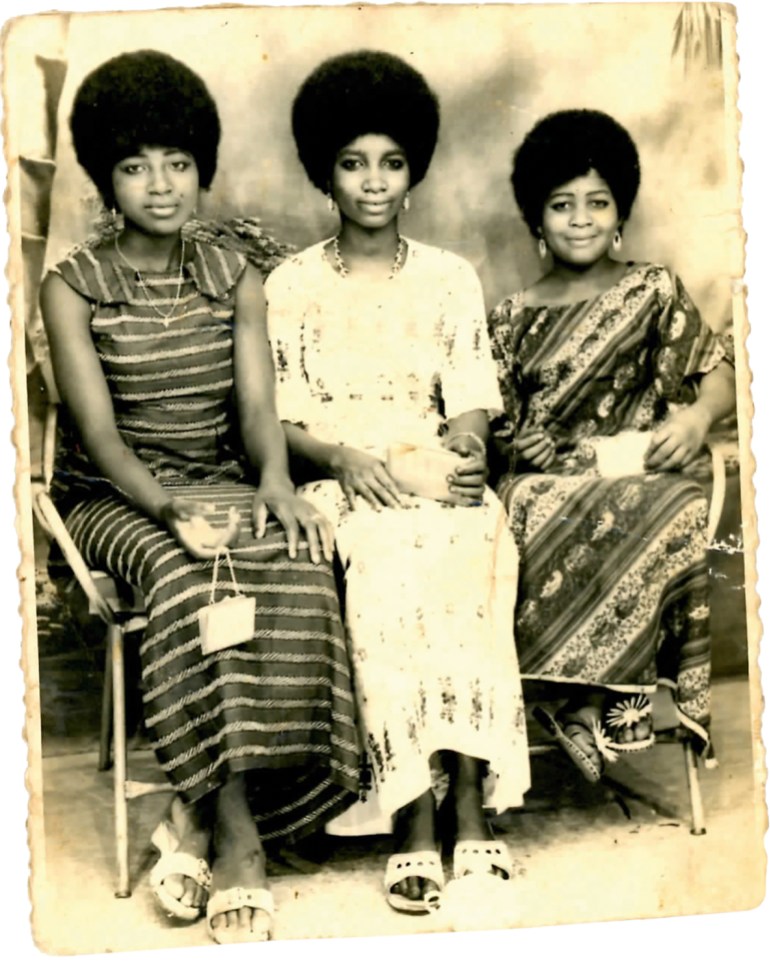 Friends Who Know What to Do, c. 1972, photographer unknown, Ghana [Courtesy of The McKinley Collection]
Friends Who Know What to Do, c. 1972, photographer unknown, Ghana [Courtesy of The McKinley Collection]“These were photographs that reclaimed the African image for Africans, and this is what is so mesmerising about them. Because you’re seeing a peek into how people saw themselves, which is really different from the narrative that had been established by the West,” says Mengiste.
McKinley’s collection now consists of thousands of images. She would like to continue to do exhibitions and collaborations, especially with African artists. “I’d like to build an institute for the works. My model is the Arab Image Foundation [in Lebanon], which actually has interesting holdings of Senegalese and other African photos, from mostly Lebanese-owned West African studios.”
“I think what the eye sees is only part of the story,” says Mengiste. “Photography tends to trick us into thinking we know everything just by looking. What fascinates me about Catherine’s work is that she’s digging past that first layer of narrative and looking at what else is revealed in those images.“
“There are untold surprises,” says McKinley. “Each photo reveals more of a large scale social history. There are many, many photo archives emerging – each with its own focus and intent and professional seriousness. I think my biggest surprise is the fact that there was such an utter dearth in the documenting and study of African women photographers, and also of interest in the stories of the female sitters, who hold up the archive with their beauty and pain.”

No comments:
Post a Comment